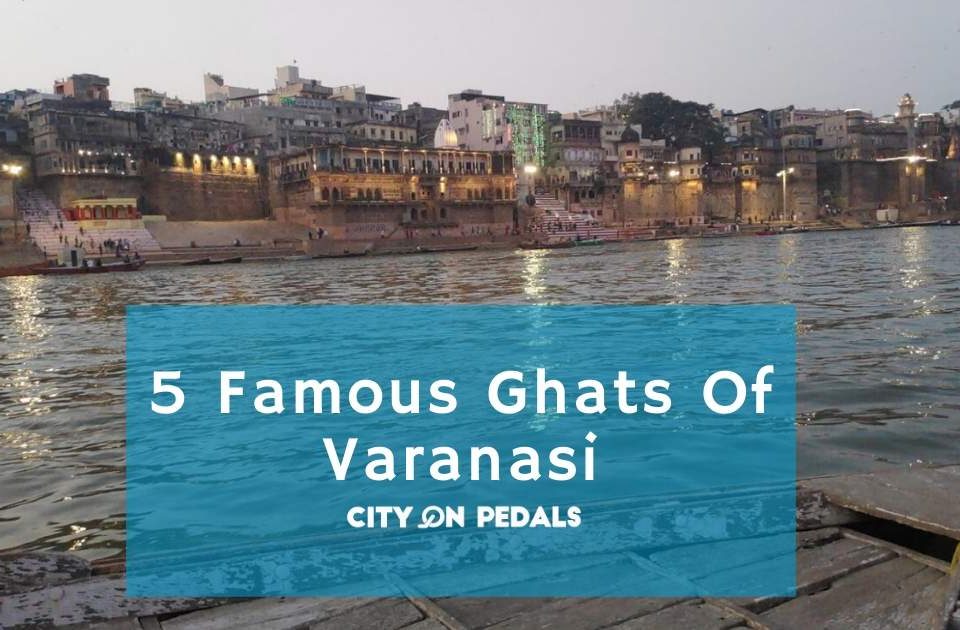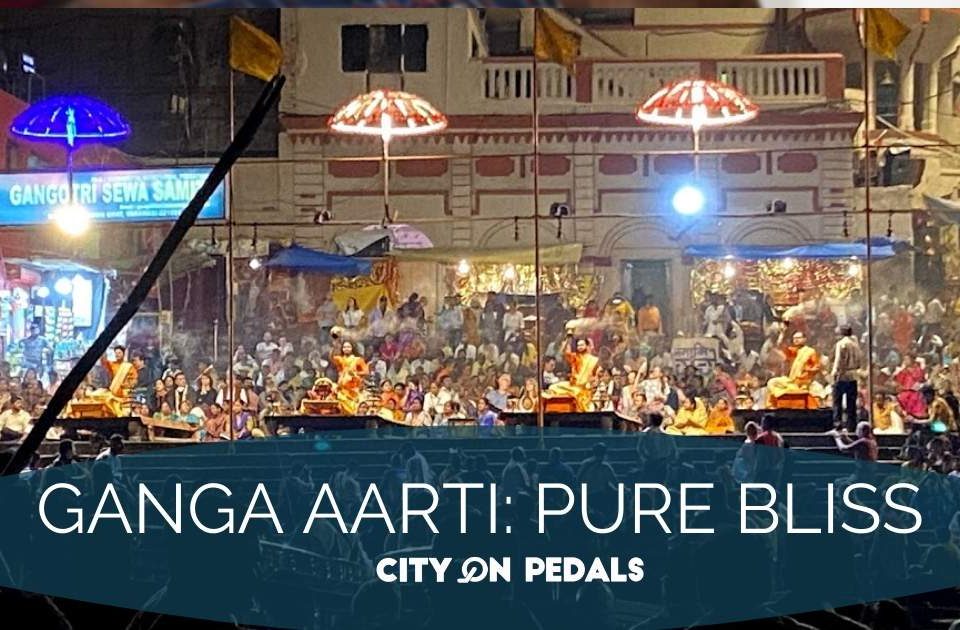- Use promo code "CPT10" & get 10% off on tours
- traveldesk@cityonpedals.com
Varanasi – A City Of Temples

Kashi Vishwanath Ki Nagri, as Varanasi is commonly called is a place that was ruled by Mughals and Kings in the past. This land of diverse Culture & Heritage, Rituals and beliefs, is one of the continuously inhabited cities of the world. A city that has a beautiful amalgamation of our religious past and a modern future which is also a hub for many saints and sages in the present has got the stature of being the Oldest City of India. The city has the finest river frontage in India with miles of Ghats or steps for religious bathing, an array of shrines and temples and various other beautiful palaces. Being the center of Hindu learning, Kashi – (another name of Varanasi) is also a city of learned scholars that run countless such schools for the continuation of traditional learning.
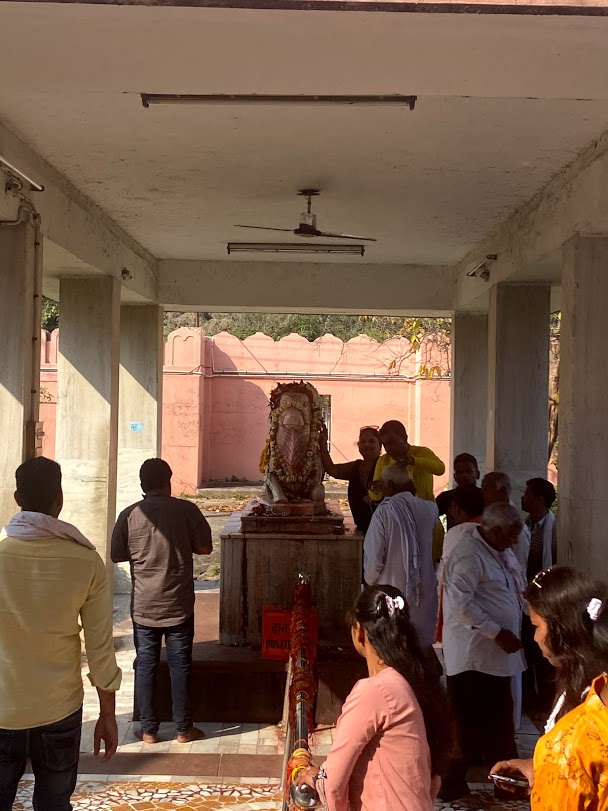
“Yahaan Madhav Ki Chaaya Hai Aur Moksha Ki Maaya Hai”.
Talking about this religious capital of the country, today through our blog, we will take a stroll to its famous temples and the presiding deities of these temples. Apart from learning about the importance of these temples, we will also take a step in the history to know about the historic significance of these temples. Our list of temples include the following:
- Kashi Vishwanath Temple
- Durga Temple
- Tulsi Manas Temple
- Tridev Temple
- Birla Temple
- Nepalese Temple
- Chinese Temple
- Sankat Mochan Mandir
- Vishalakshmi Temple
- Kalbhairava Mandir
1. Kashi Vishwanath Temple
This is one of the holiest Shiva Temple of the city. As the name suggests it is a temple on the name of Supreme Lord of Universe – Lord Shiva who is the presiding deity of this temple. Thus Kashi is also known as the city of Lord Shiva. The temple houses a “Shivalinga” – (an abstract or an iconic representation of the Hindu deity Shiva in Shaivism) which is said to be amongst one of the 12 Jyotirlingas of Shiva. These are said to be the fiery pillars of light by which Lord Shiva beckoned his divine supremacy over all other Gods, broke through earth’s crust and gleam towards heaven. It is believed that Varanasi is a place where the first Jyotirlinga manifested itself.
Kashi is believed to be at the center of the Hindu doctrine of cosmogony. If Kashi is at the heart of Hinduism, then Kashi Vishwanath Temple is the heartbeat of this godly land. But this temple has undergone various tests of time when it was marred by many atrocious events of history. The temple has been demolished several times by kings and rulers of the country time and again. First by Qutb-ud-din Aibak, then during the reign of Illtutmish, followed by Sikandar Lodhi and lastly, it was demolished by Emperor Aurangzeb’s crusader activities to propagate Islam. But it is remarkable to see how the temple still stands tall in all its majesty and glory. The temple is also called the Golden Temple of Varanasi as Maharaja Ranjit Singh donated about 1000 kg gold here of which the dome of the temple is built.
Being an important city of Hindus, a city of Lord Shiva, the temple is believed to possess powers of salvation – a Mukti from the cycle of birth and death. People have a staunch belief that here Lord Shiva gives the ultimate Tarak Mantra to the ones who are in their last few days of life due to which they achieve a stage of salvation. People also have a belief that if you pray to Kashi Vishwanath regularly, all your desires are fulfilled. Therefore, situated amidst the narrow lanes of the city, the serene temple is mostly jammed with swarms of people who have come here for darshan of their Supreme Lord.
2. Durga Temple
Goddess Durga is considered as the idol of strength in Hindu mythology. Dedicated to her is a temple constructed by a Bengali Maharani – The queen of Bengal, who was a staunch believer of the Goddess. As per the excerpts of history, the temple has a very interesting and mythological story related to it.

Once the Kashi Naresh – the King of Kashi called for a Swayamvar – (where a person gets a right to choose a partner for life) for his only daughter Shashikala’s marriage but he came to know that the princess was in love with Prince Sudarshan. So he secretly got his daughter married to Sudarshan. When all other suitors who came for Swayamvar to get to know about their marriage, they rage a war against the King and Sudarshan. Being a staunch believer of Maa Durga, Sudarshan calls for prayers to the deity who is then believed to come on lion and fought a war for them both. Then Kashi Naresh pleaded Maa Durga to protect the city of Kashi always and eradicate the evil. So it is believed that the idol of the deity inside the temple was not constructed by any human rather it appeared on its own.
Then in the 18th C, the temple was built in North Indian Nagara style of architecture and the entire temple was painted red to match the color of the idol of Maa Durga inside which is seen majestically sitting on a lion armed with a trident, sword and a discus in the hands. This temple represents a staunch belief system that if you trust God, He will always come to your rescue.
3. Tulsi Manas Temple
Dedicated to Lord Rama, Tulsi Manas is one of the most famous temples of Varanasi. The temple is situated amidst a beautiful garden and is made up of white marble. this temple has a great historical importance as this is the place where the great epic of Ramcharitmanas – the lakes of deeds of Lord Rama, was written by a revered Hindu poet-saint Tulsidas Ji in 16th C in Hindi language.
Constructed by the Sureka family of Bandhaghat, Howrah, West Bengal the temple’s walls depict various verses and scenes from the epic and are primarily dedicated to Lord Rama, Mata Sita, Lakshaman and Lord Hanuman. the temple was inaugurated by HH Dr. Sarvapalli Radhakrishnan.
4. Tridev Temple
This is another holy temple in the pious city of Varanasi which is nearby to Tulsi Manas Temple. As the name suggests, the temple is dedicated to three lords – “tri” means “three” and “dev” means “Gods”. They are Salasar Lord Hanuman, Dadi Rani Devi Sati, and Khatu Ji Maharaj. It is believed that the spiritual atmosphere of the temple helps them to form a divine connection with God. This is one of the reasons that people visit here from far off places to attain a spiritual calm and strength from Almighty. Being one of the famous temples of the city, people make sure to visit here during their trips to Kashi or Varanasi.
5. Birla Temple
As the city of Varanasi is said to be called the city of Vishwanath – Lord Shiva, there is another famous Kashi Vishwanath Temple here. Since the temple was founded by the Raja Birla of the Birla family of great industrialists in the vicinity of Banaras Hindu University, it is given the name of Birla temple. Planned by Pt. Madan Mohan Malaviya (the founder of the Banaras Hindu University) as part of the BHU campus is a circle of nine temples dedicated to different deities. The Temple is open to all the people irrespective of many castes and religions.
Being dedicated to Lord Shiva, this temple is an exact copy of the original Vishwanath Temple. The center of the temple has a Shiva lingam – the idol of Lord Shiva and the walls of the temple have inscriptions of the Hindu scriptures. Being a matchless and ostentatious temple in the entire Varanasi, the tower of the temple is known as the tallest temple tower which is taller than the Qutub Minar. A large swarm of devotees from across the globe visit here to pay homage to the deity. Loud sounds of “Har Har Mahadev” – (Hail the deity) and Jai Bholenath echoes in the air. Monday is a special day when devotees perform worship of Lord Shiva in order to fulfill their wishes. Every Monday Rudrabhishek is performed in the vicinity of the temple.
6. Nepalese Temple
Close to river Ganga, Nepali temple is a small but beautiful temple situated at Lalita Ghat. As the name suggests temple was constructed by the king of Nepal Rana Bhadur Shah during his exile period from 1800 AD to 1804 AD due to his decision of staying in the city and making a replica of Pashupatinath Temple in Varanasi. Although the construction work of the temple started during his period of stay in Varanasi but then Shah moved back to Nepal while the construction of the temple was still going on. Later on, Rana Bahadur Shah died and the project got completed by his son Girvan Yuddha Bikram Shah Deva 20 years after the planned deadline. After that, the land was transferred to Rana Bahadur Shah by the king of Nepal in 1843.
The temple is also called mini Khajuraho because the sculptures of the temple are similar to the ones displayed in the Khajuraho group of monuments. Made up of terracotta, stone, and wood, ethically temple took around three decades to reach its final shape. The architecture of the temple was made ina Pagoda style – (five-storey Pagoda), where the entire wood is termite-free. So during your next visit to the city of temples, you should not miss visiting here.
7. Chinese Temple
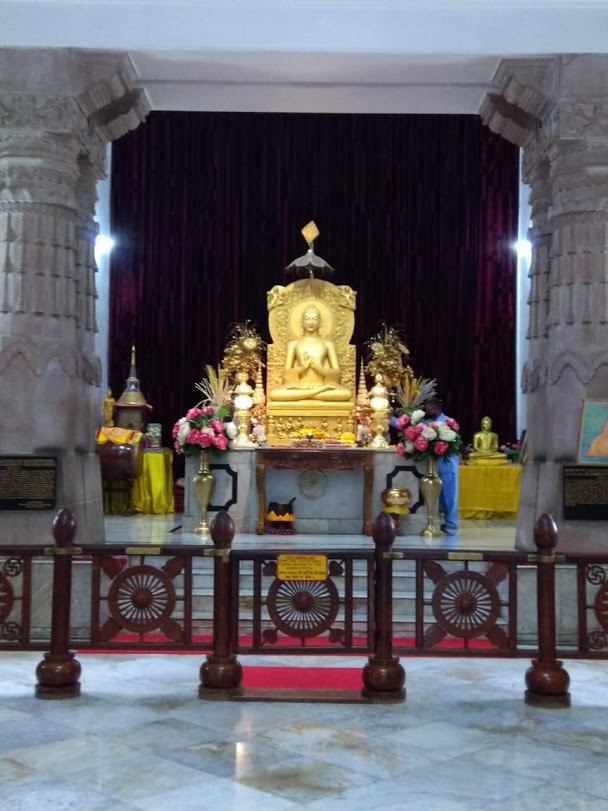
As the name signifies, the temple is built by a Chinese and is dedicated to the Lord Gautam Buddha. The temple building is made of bright red and yellow color by the devotees of Buddha. It is believed and revered as a site where Lord Buddha met his five disciples and delivered his first sermon after attaining enlightenment in the deer park. There is a fig-tree here which is an offshoot of the original Bodhi tree under which Lord Buddha acquired true knowledge.

There are basically four Buddhist pilgrimage destinations in India, Sarnath being the most important shrines of them all. There is a stupa erected in the temple by Emperor Ashoka who also wants to spread the teachings of Buddhism in the world during his reign. There is an idol of Lord rendering sermons to his four Buddhist monks. The sleeping idol of the temple seems to be bathed in the golden hue. The temple is maintained by monks from China, Japan, and Tibet. It is actually every person’s dream to visit Sarnath once in their lifetime that is the reason that the Buddhists converge from around the world to offer prayers to the deity.
8. Sankat Mochan Temple
A temple dedicated to the monkey-God, Lord Hanuman who is believed to be the reliever of all troubles – Sankat Mochan. Situated on the banks of Assi Ghat the temple was established by saint Goswami Tulsidas and is said to build on the exact same spot where Tulsidas Ji had a vision of Lord Hanuman when he was writing Ramcharitmanas.
The unique feature of the temple is the idol of Lord Hanuman facing his Lord Rama whom he worshipped with a selfless devotion. “Besan Ke Laddoo” is served as an offering to Lord hanuman here. It is a firm belief that if you visit this temple regularly with a firm devotion to Lord, Sankat Mochan – as the Lord is called dearly, will fulfill all your wishes and make you rid of all the worries and troubles. So mainly on every Tuesdays and Saturdays, a swarm of devotees can be seen here to offer prayers to the monkey-God. Also one can see a lot of monkeys in and around the temple vicinity so one should be really careful in taking anything along.
9. Manikarnika Temple
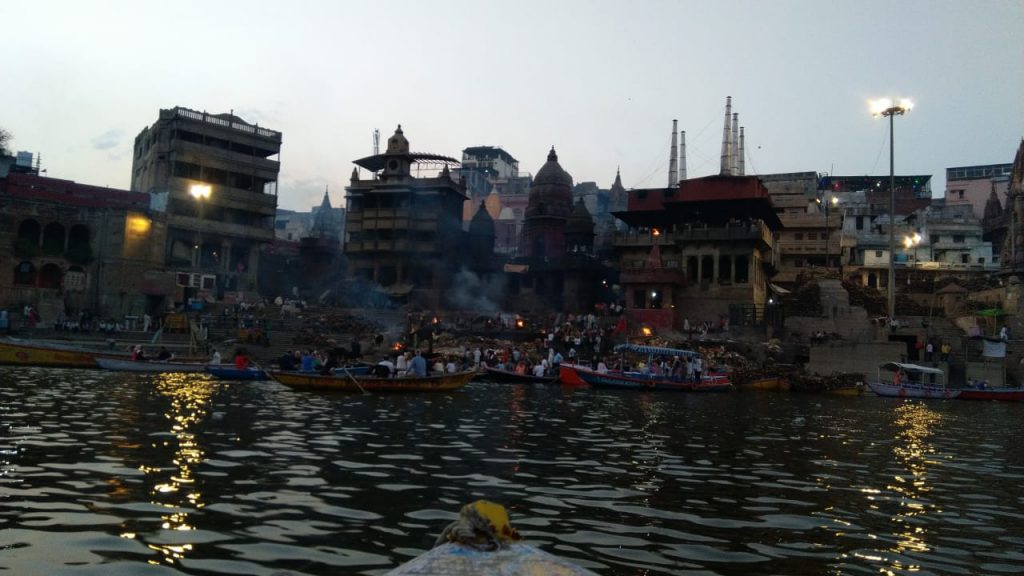
Situated at the most important Ghat of the city, Manikarnika Ghat or the Burning Ghat, the temple is famous for the ancient fire that is burning inside for ages. There is again an interesting story about the temple fire. It is believed that due to a boon by Lord Shiva, He said that whosoever’s pyre will be lighted first by this fire will attain a complete salvation thereby getting rid of the cycle of death and re-birth. This is the reason that during their old-age people want to visit and stay in Varanasi to attain Moksha (salvation).
There is also a holy pond named Manikarnika Kund which is believed to be dug by Lord Vishnu. Since the Lord has also meditated for many years at this ghat, their footprints – Chandrapaduka is here on a circular marble slab.
10. Kalbhairava Mandir
One of the oldest Shiva Temple in Kashi Nagari. The temple is dedicated to Kal Bhairav – a fierce form of Shiva, who is believed to be the Kotwal – (the chief Police Officer) of Varanasi. The deity is believed to be portrayed as a human with a gesture of anger. It is a staunch belief that anyone who wants to settle in Varanasi needs to take his permission and if anyone wants to move out of Varanasi also needs to take his permission. He is the deciding authority that when and who will reside in Varanasi. Whatever happens in the city of Banaras it is by the wish and will of the deity – Bhairava Baba.
According to a famous folklore, not only of the people, but Baba is believed to be the King of all the Gods. As the word Kal means both death and fate, it is believed that even death is afraid of Kaal Bhairava. Baba’s idol can be seen in silver color housed in the inner sanctum of the temple seated on his Vahana – (vehicle) a dog. In his fierce gesture, wearing a garland of skulls and holding a trident. The face of the deity is covered with garlands and is visible to people while the rest of the body is covered with loose cloth. As you walk around the temple, you will see the holy men seated with a peculiar kind of a fan of the peacock feathers in their hands which is believed to wade-off all the sins of the pilgrims and bless them. Sundays and Tuesdays are considered to be the important days to offer prayer to the deity.
Therefore, taking a round trip of the temples which are approx. 1500 temples in the entire Banaras, we have covered only 10 most important temples which even you can visit even during your short tour of the city. So take a whole new experience of divinity and share it with us.

